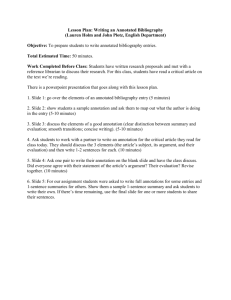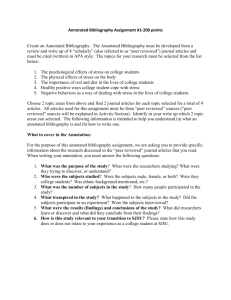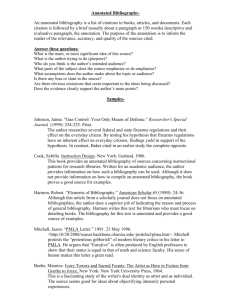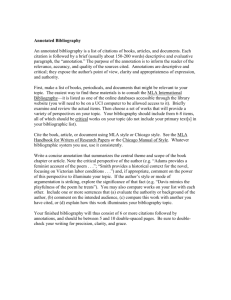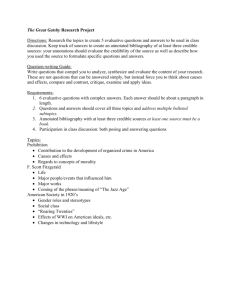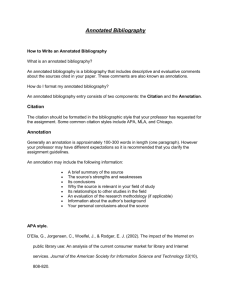Annotated Bibliography Lesson Plan (.DOC)
advertisement
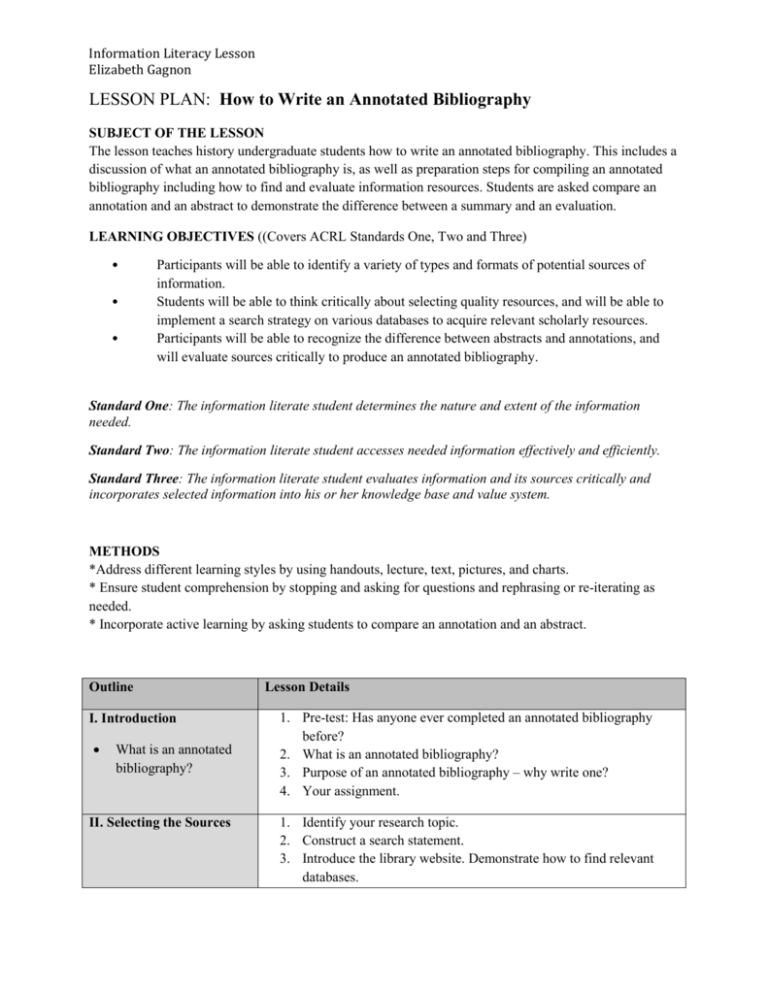
Information Literacy Lesson Elizabeth Gagnon LESSON PLAN: How to Write an Annotated Bibliography SUBJECT OF THE LESSON The lesson teaches history undergraduate students how to write an annotated bibliography. This includes a discussion of what an annotated bibliography is, as well as preparation steps for compiling an annotated bibliography including how to find and evaluate information resources. Students are asked compare an annotation and an abstract to demonstrate the difference between a summary and an evaluation. LEARNING OBJECTIVES ((Covers ACRL Standards One, Two and Three) • • • Participants will be able to identify a variety of types and formats of potential sources of information. Students will be able to think critically about selecting quality resources, and will be able to implement a search strategy on various databases to acquire relevant scholarly resources. Participants will be able to recognize the difference between abstracts and annotations, and will evaluate sources critically to produce an annotated bibliography. Standard One: The information literate student determines the nature and extent of the information needed. Standard Two: The information literate student accesses needed information effectively and efficiently. Standard Three: The information literate student evaluates information and its sources critically and incorporates selected information into his or her knowledge base and value system. METHODS *Address different learning styles by using handouts, lecture, text, pictures, and charts. * Ensure student comprehension by stopping and asking for questions and rephrasing or re-iterating as needed. * Incorporate active learning by asking students to compare an annotation and an abstract. Outline I. Introduction What is an annotated bibliography? II. Selecting the Sources Lesson Details 1. Pre-test: Has anyone ever completed an annotated bibliography before? 2. What is an annotated bibliography? 3. Purpose of an annotated bibliography – why write one? 4. Your assignment. 1. Identify your research topic. 2. Construct a search statement. 3. Introduce the library website. Demonstrate how to find relevant databases. i. Search tips and tricks for building a bibliography. III. Evaluating Information Sources 1. Components of an annotation. 2. Topics to consider when reading your information sources. Skills Practice 1. Post-test: Conduct a comparison exercise where students take 1-2 minutes to read an abstract and an annotation on the same resource, and consider the difference between the two. 2. Students will then be asked to highlight the components of an annotation. What is the main difference between an annotation and an abstract? Wrap Up 1. Review the steps to preparing an annotated bibliograph, reiterating what we’ve covered in this presentation. 2. Avoiding plagiarism 3. Where to go for citation management help: http://library.algomau.ca/main/?q=node/1274 Reference List Lesson Planning University of Texas at Arlington. Active Learning Techniques. Accessed May 16, 2015. Retrieved from: http://activelearning.uta.edu/FacStaff/ALtechniques.htm. University of Waterloo. LINC Toolkit. Accessed May 16, 2015. Retrieved from: http://subjectguides.uwaterloo.ca/linctoolkit Annotated Bibliography Resources http://seneca.libguides.com/c.php?g=20659&p=160657 http://www.aacc.edu/library/file/annotatedbib.pdf http://www.lib.uwo.ca/tutorials/annotatedbibliographies/ http://www.lib.uoguelph.ca/get-assistance/writing/specific-types-papers/writing-annotatedbibliography http://help.library.ubc.ca/planning-your-research/how-to-write-an-annotated-bibliography/
